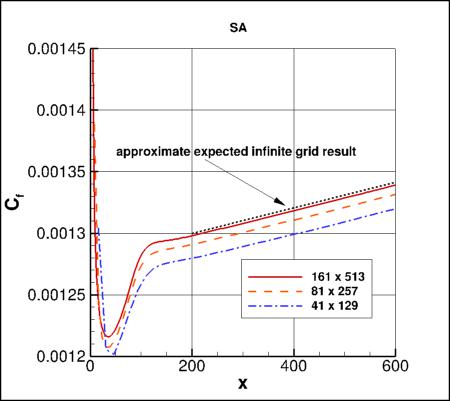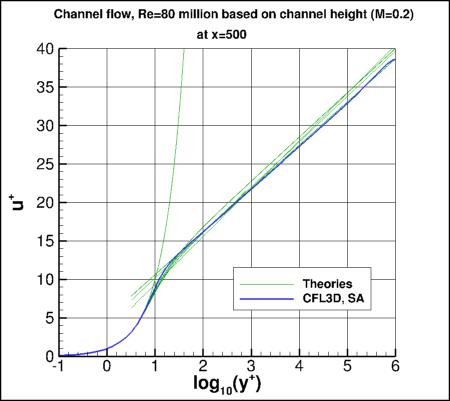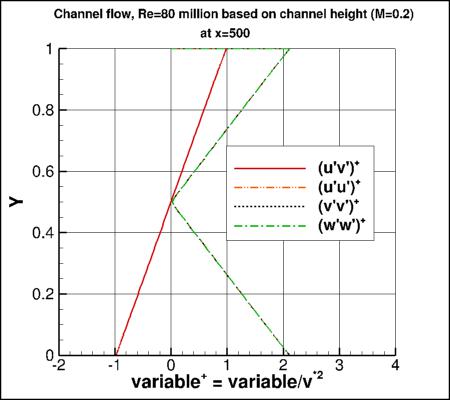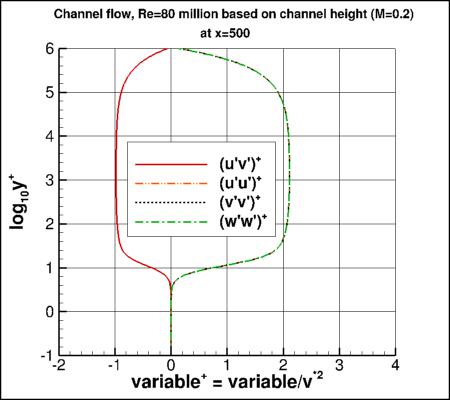 |
Langley Research CenterTurbulence Modeling Resource |
Jump to: SA-QCR2000 Results, SSTm Results, SSG/LRR-RSM-w2012 Results, Wilcox2006-klim-m Results, K-kL-MEAH2015 Results
Return to: Fully-Developed Channel Flow Validation Intro Page
Return to: Turbulence Modeling Resource Home Page
2D Fully-Developed Channel Flow at High Reynolds Number Validation Case
SA Model Results
Link to SA equations
Above SA results are from CFL3D on the finest 161x513 grid.
CFL3D used freestream value of the SA turbulence field variable (relative to laminar)=3.
Please read note 5 on Notes on running CFD page.
Note that these are compressible code results; results will be somewhat different for incompressible codes.
In fact, for incompressible flow, the Cf and v*/Uref should become constant (moving downstream) rather
than slowly linearly increasing as shown here.
Note that the quantity v* (as defined in
White, F. M., Viscous Fluid Flow, McGraw-Hill, New York, 1974, pp. 471-474) is often referred to as u_tau.
Note also that Uref used in the above plots is not bulk velocity, but rather
the velocity at the reference position upstream where M=0.2.
The density (used to compute Cf) is also referenced there.
Results are assumed to be sufficiently "fully developed" by
x=500. Looking at the "Karman Measure" (KM), the value of
"kappa" produced by this turbulence model is close to 0.412 over much of the log layer.
The SA model does not produce a value for the turbulent kinetic energy (k),
which is needed for the normal stresses u'u', v'v', and w'w'.
However, k for SA is sometimes estimated by using the following approximation, or something similar
(see AIAA Paper 92-0439):
nu_t*sqrt(2*Sij*Sij)/a1, where a typical value for a1 is a1=0.31.
Here, this approximation is made solely for visualizing the normal stresses (it is not done while solving the
Navier-Stokes equations). For more details, see discussion on the
SA-QCR2000 Expected Results - 2D Zero Pressure Gradient Flat Plate page.
Because SA is a linear (Boussinesq) model, there is essentially no separation between u'u', v'v', and w'w'.
CFL3D results are given here:
sa_cf_vs_x_cfl3d.dat,
sa_utau_vs_x_cfl3d.dat,
sa_u_cfl3d.dat,
sa_u+y+KM_cfl3d.dat,
sa_mut_cfl3d.dat,
sa_plus_cfl3d.dat.
A typical CFL3D input file is:
sa_cfl3d_typical.inp.
Jump to: SA-QCR2000 Results,
SSTm Results,
SSG/LRR-RSM-w2012 Results,
Wilcox2006-klim-m Results,
K-kL-MEAH2015 Results Return to: Fully-Developed Channel Flow Validation Intro Page Return to: Turbulence Modeling Resource Home Page
Recent significant updates: Responsible NASA Official:
Ethan Vogel








02/01/2022 - added mention of expected results for incompressible flow
Page Curator:
Clark Pederson
Last Updated: 02/01/2022